Apr
3
2012
or As Far as the East is from the West
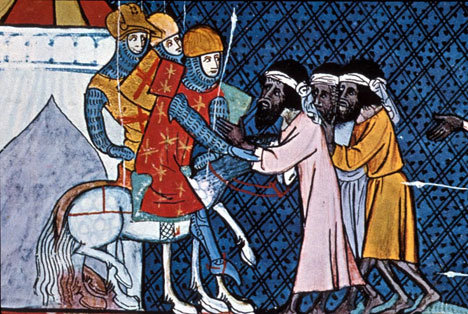
“That very day Pilate and Herod became friends with each other, for previously they had been at enmity with each other.” (Luke 23:12)
“Secular humanism and Islam are merely the bipolar moods of Christless Christianity. They can be united only in suicide.”
Getting a grip on the Tabernacle layout helps us understand the architecture of Creation, the history of mankind and the structure of the entire Bible. After reading Mark Steyn on the Islamic/secular conflict in Europe, I was thinking that the same “Tabernacle” categories can be found in the world today. Whatever we do, however much we distort the truth, we are still bound by the walls and furnitures set up in Genesis 1. And, in my humble opinion, the light this sheds on the current conflict is not only revealing concerning its true nature, but it also helps us to predict its future.
Continue reading
Comments Off | tags: AD70, Church History, Culture, David P. Goldman, Herod, Incense Altar, Islam, Lampstand, Mark Steyn, Martyrdom, Melchizedek, Tabernacle | posted in Bible Matrix, Biblical Theology, The Last Days
Aug
12
2011

“…sprinkling or pouring conflates the Covenant head with the Covenant body.”
Doug Wilson writes:
“God, in baptizing the disciples with the Holy Spirit at Pentecost, did so by pouring out His Spirit upon them. Pouring is therefore very clearly described as a biblical mode of baptism” (To a Thousand Generations, p. 102).
God poured out the Spirit, certainly. But can we then assume that the apostles poured water on new believers and their babies? Single words are clues, but they can be misleading. The effectiveness of word studies is limited because context is crucial. And the context of the Bible is most importantly structural. Structure is the answer.
The reason is that all of God’s new creations follow the structure of Genesis 1. It’s almost like, when God speaks, the Spirit will pick up anything available, anything lying around, and arrange it into the familiar pattern. This means that the Bible Matrix is crucial in identifying the meanings of many Bible symbols. Baptism and the Day of Atonement might not look anything like each other to us, but the Bible keeps tying them together, along with some other things, to tell us the same part of the Creation story. If we have eyes to see, this method also gives us hints as to the correct mode of baptism. It’s not about the motion of the water. It’s about the motion of the one being baptized. [1]
Continue reading
3 comments | tags: Baptism, Corinthians, Covenant Theology, Daniel, Doug Wilson, Incense Altar, Totus Christus | posted in Bible Matrix, Biblical Theology, The Last Days
Mar
15
2011
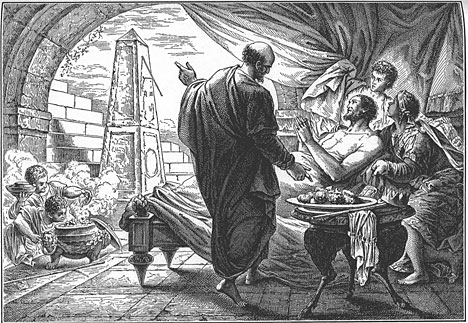
or Raising Up the Temple
An analysis of the literary structure of Day 5 of Creation and passages that are apparently parallel.
Continue reading
Comments Off | tags: Altar of the Abyss, Chiasm, Creation Week, Deuteronomy, Ezekiel, Genesis, Hezekiah, Incense Altar, Isaiah, Literary Structure, Tabernacle | posted in Bible Matrix, Biblical Theology, Creation, The Last Days
Jan
13
2011
or Discerning the True Sword
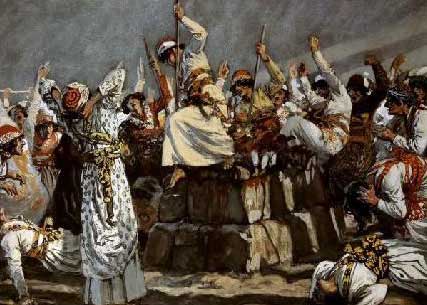
“Beware of dogs, beware of evil workers, beware of the mutilation!”
Philippians 3:2 (NKJV)
Jeff Meyers copped flak for his take on the parable of the Pharisee and the tax collector. He says the tax collector was justified for his Covenant faithfulness, and the Pharisee was not. Was it not the Pharisee who was faithful? And, either way, is this not justification by works? Has Jeff got night and day around the wrong way?
Continue reading
2 comments | tags: AD70, Exodus, Federal Vision, Incense Altar, Jeff Meyers, Tabernacle, Worship, Worship as commerce | posted in Bible Matrix, Biblical Theology, The Last Days
Jul
27
2010
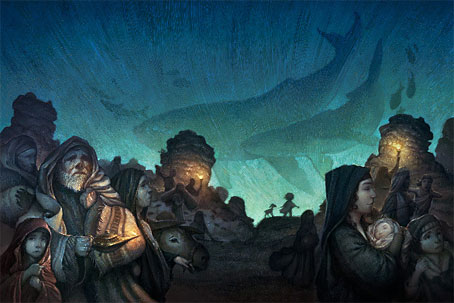
Adam couldn’t face God. Cain’s face fell. Moses’ face shone with reflected light when he returned from the mountain of God. Bezalel and Aholiab constructed the Table of Facebread, which corresponded in the cherubim to the Face Of The Man. David and his men ate the facebread. Saul feared Goliath, but David’s face was red, literally “filled with blood,” before he bloodied Goliath’s face and the usurper fell facedown. [1]
Continue reading
2 comments | tags: Altar of the Abyss, Ascension, Circumcision, Creation Week, Genesis, Incense Altar, Pentecostal, Revelation, Systematic typology, Table of Showbread | posted in Bible Matrix, Biblical Theology, Creation, The Last Days
Feb
24
2010
or Meat to Eat – 1
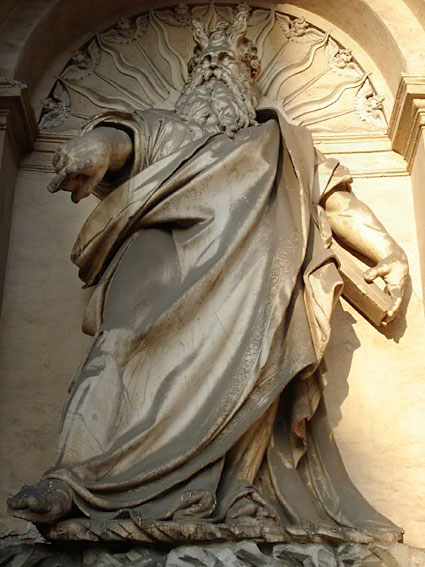
“And whanne Moises cam doun fro the hil of Synai, he helde twei tablis of witnessyng, and he wiste not that his face was horned of the felouschipe of Goddis word..” —Exodus 34:29, Wycliffe
Perhaps you’ve seen those bumper stickers that say, “If we’re not meant to eat animals, why are they made of meat?”
NOTE: THIS POST HAS BEEN REMIXED AND INCLUDED IN GOD’S KITCHEN.
You must be logged in to see the rest of this post.
Join now for a year for $15!
From memory, men didn’t eat meat until after the flood. The history from Adam to Noah follows the Feasts pattern, with Adam as the Alpha male (heh) and Noah as the mature and wise Omega male of that initial process. [1] Moving from vegetarianism (literally “seeds”) to meat was not only a sign of judgment, but a sign of greater judgment put into the hands of God’s Man. [2] Noah could eat meat, and he could also sentence murderers to death. Man now had teeth in a way he had never had them before. Even we use the phrase “toothless” to refer to ineffective pieces of legislation. As mentioned elsewhere here, teeth and tusks and ivory and horns are symbols of justice, whether they be on men, animals, or altars. [3] A blood-covered horn means the crime is atoned for. Just as Christ was a Lamb with seven horns, worthy to open the scroll, Moses came down from Sinai with not only a “scroll” (or tablets in that case) but “horns.” This translation has been dismissed as errant, but perhaps the reason for it should not be dismissed so easily. Here’s my attempt at an interpretation.
Continue reading
Comments Off | tags: Adam, Exodus, Incense Altar, Ivory, Moses, Noah, Tabernacle, Vegetarianism | posted in Biblical Theology, Creation
Feb
19
2010
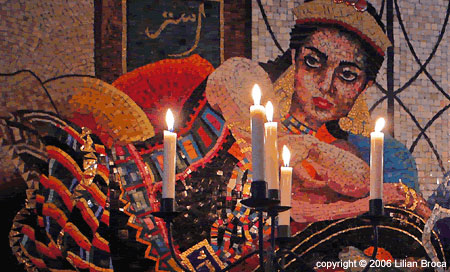
or Smells Like Holy Spirit
A friend recently gave me a unique gift. With some difficulty and great expense, he sourced the ingredients for the anointing oil of the Aaronic priesthood and I was the grateful recipient of a small, blue vial.
The scent of the oil is intoxicating. You breathe it in and in some strange way you can “taste” it as it goes down. It is extremely complex and yet a single fragrance. Continue reading
Comments Off | tags: Ark of the Covenant, Atonement, Covenant Theology, Creation Week, David, Esther, Ezekiel, Genesis, Greater Eve, Incense Altar, James Jordan, Peter Leithart, Resurrection, Saul, Tabernacle | posted in Biblical Theology, Quotes, The Last Days, The Restoration Era
Nov
3
2009
or Every Knee Shall Bow
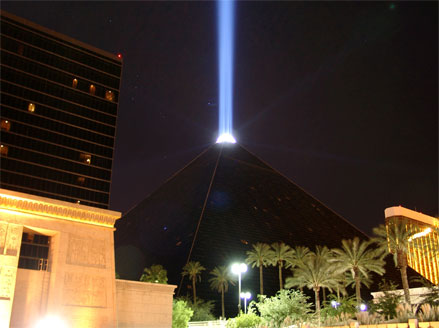
Day 1
So, Adam fouled the first Sabbath. He failed to be Light.
Day 2
Cain made a false exodus (with Abel as the Passover lamb) and went to “worship in the wilderness.” God marked him as a “covering.” Being “barren”, Cain built a city as a covering, but it was just like Adam’s figleaves. It was a phony firmament, a fabricated Covenant, a city built on the wrong sort of blood.
Day 3
His offspring built a counterfeit Tabernacle – in opposition to the worship at the Gate of Eden. This was a false Land, a false mountain, like Mount Gerizim became to the Samaritans. Lamech, as a false Moses, “ascended” not as a Lamb slain, but as an accuser, the incarnation of the serpent. But someone true ascended as Firstfruits: Enoch.
This brings us to Day 4. As in the Garden, and as in Israel’s wilderness, the test was harlotry.
Continue reading
Comments Off | tags: Abel, Babylon, Cain, Egypt, Enoch, Genesis, Herod, Incense Altar, Lamech, Noah, Satan, Seth, Sodom | posted in Biblical Theology, The Last Days
Sep
27
2009
Or The Tabernacle in Genesis 3
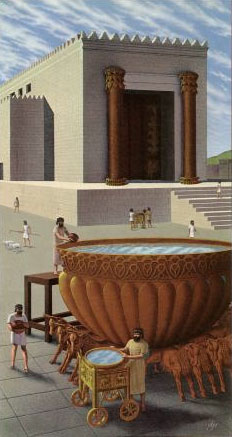 One of the best things you get from James Jordan is a big handle on the Tabernacle.[1] It was a miniature of the creation. It was also a further development of the Garden of Eden, being more glorious than the Garden itself (the trees were now worked timber, and the wood was covered in precious metal).
One of the best things you get from James Jordan is a big handle on the Tabernacle.[1] It was a miniature of the creation. It was also a further development of the Garden of Eden, being more glorious than the Garden itself (the trees were now worked timber, and the wood was covered in precious metal).
Jordan’s theory that Satan was to be a tutor to Adam and Eve, but fell in the moment he deceived them, finds support in the Tabernacle layout. (Angels tutor God’s people throughout the Old Testament.) Satan was the secondary lightbearer, the Lampstand, facing north.
Adam was to be broken bread and poured out wine, the Face of the Man, facing south, the Table of Showbread (the facebread).
Between them, Eve, the mother of all living, was the Altar of Incense. As element 5, Day 5, she is a “multitude” in one body. She is awesome as an army with banners. Women possess all their ova from birth.[2] Continue reading
Comments Off | tags: Greater Eve, Holy Place, Incense Altar, James Jordan, Lampstand, Parenting, Satan, Showbread, Tabernacle, Temple | posted in Biblical Theology, Creation
Sep
18
2009
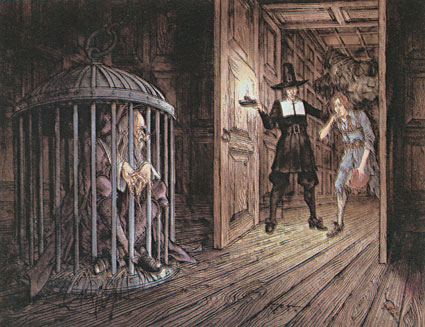
I saw in my dream, that the Interpreter took Christian by the hand again, and led him into a very dark room, where there sat a man in an iron cage. Now the man seemed very sad. He sat with his eyes looking down to the ground, and his hands folded together, and he sighed as if his heart would break.
Then said Christian, “Who is this?”
“Talk with him and see,” said the Interpreter.
“What used you to be?” asked Christian.
“I was once a flourishing professor, both in my own eyes, and also in the eyes of others,” answered the man. “I was on my way, as I thought, to the Celestial City and I was confident that I would get there.”
“But what did you do to bring yourself to this condition?” Christian asked.
“I failed to keep watch,” the man replied. “I followed the pleasures of this world, which promised me all manner of delights. But they proved to be an empty bubble. And now I am shut up in this iron cage—a man of despair who can’t get out.”
No further explanations were given. No one said who put him there. But the Interpreter whispered to Christian:
“Bear well in mind what you have seen.” [1]
. . . . . . . . . . . . . . . . . . . . . . . . . . . . . . . . . . . . . . .
Another thought related to the ideas in Behind Closed Doors.
The whole aim of the construction process, whether in sex, foetal development, education, business, art, music, family or state government, is the ultimate revelation of a mature glory. We are given the opportunity to create, and that involves certain God-given freedoms. If the freedoms are abused, what we construct for ourselves is a cage. Lust is a cage. A dysfunctional family or state is a cage. Enforced egalitarian socio-economics is a cage. Undisciplined children are a cage.
Jesus laid down His life for this world, and the freedoms of western culture have been a direct outcome. In its final stages, we have rebelliously inverted each of these freedoms (including the economic ones) and turned both our Christian protection (including our God-given wealth) and Christian mandate into a cage. Ancient Israel did the same. Why does this inversion process seem such a logical path for fallen human nature?
Continue reading
3 comments | tags: Altar of the Abyss, Babel, Biblical worldview, Culture, Dominion Theology, Doug Wilson, Economics, Incense Altar, John Bunyan, Parenting, Politics, Postmillennialism, Solomon, Tabernacle, Worship, Worship as commerce | posted in Christian Life, Quotes



































